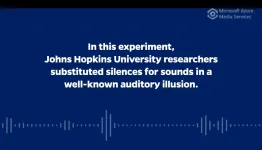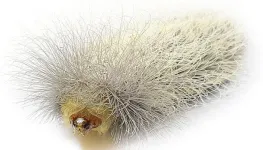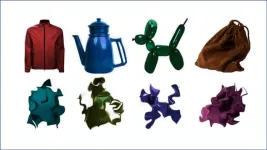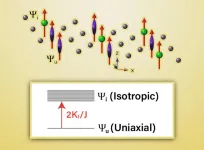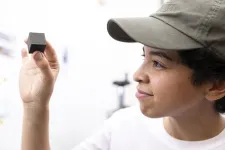(Press-News.org) Silence might not be deafening but it’s something that literally can be heard, concludes a team of philosophers and psychologists who used auditory illusions to reveal how moments of silence distort people’s perception of time.
The findings address the debate of whether people can hear more than sounds, which has puzzled philosophers for centuries.
“We typically think of our sense of hearing as being concerned with sounds. But silence, whatever it is, is not a sound — it’s the absence of sound,” said lead author Rui Zhe Goh, a Johns Hopkins University graduate student in philosophy and psychology. “Surprisingly, what our work suggests is that nothing is also something you can hear.”
The research is set to publish in Proceedings of the National Academy of Sciences.
The team adapted well-known auditory illusions to create versions in which the sounds of the original illusions were replaced by moments of silence. For example, one illusion made a sound seem much longer than it really was. In the team’s new silence-based illusion, an equivalent moment of silence also seemed longer than it really was.
The fact that these silence-based illusions produced exactly the same results as their sound-based counterparts suggests that people hear silence just like they hear sounds, the researchers said.
“Philosophers have long debated whether silence is something we can literally perceive, but there hasn’t been a scientific study aimed directly at this question,” said Chaz Firestone, an Assistant Professor of Psychological and Brain Sciences who directs the Johns Hopkins Perception & Mind Laboratory. “Our approach was to ask whether our brains treat silences the way they treat sounds. If you can get the same illusions with silences as you get with sounds, then that may be evidence that we literally hear silence after all.”
Like optical illusions that trick what people see, auditory illusions can make people hear periods of time as being longer or shorter than they actually are. One example is known as the one-is-more illusion, where one long beep seems longer than two short consecutive beeps even when the two sequences are equally long.
In tests involving 1,000 participants, the team swapped the sounds in the one-is-more illusion with moments of silence, re-working the auditory illusion into what they dubbed the one-silence-is-more illusion. They found the same results: People thought one long moment of silence was longer than two short moments of silence. Other silence illusions yielded the same outcomes as sound illusions.
Participants were asked to listen to soundscapes that simulated the din of busy restaurants, markets, and train stations. They then listened for periods within those audio tracks when all sound stopped abruptly, creating brief silences. The idea wasn’t simply that these silences made people experience illusions, the researchers said. It was that the same illusions that scientists thought could only be triggered with sounds worked just as well when the sounds were replaced by silences.
“There’s at least one thing that we hear that isn’t a sound, and that’s the silence that happens when sounds go away,” said co-author Ian Phillips, a Bloomberg Distinguished Professor of Philosophy and Psychological and Brain Sciences. “The kinds of illusions and effects that look like they are unique to the auditory processing of a sound, we also get them with silences, suggesting we really do hear absences of sound too.”
The findings establish a new way to study the perception of absence, the team said.
The researchers plan to keep exploring the extent to which people hear silence, including whether we hear silences that are not preceded by sound. They also plan to investigate visual disappearances and other examples of things people can perceive as being absent.
END
The sound of silence? Researchers prove people hear it
2023-07-10
ELSE PRESS RELEASES FROM THIS DATE:
Caterpillar venom study reveals toxins borrowed from bacteria
2023-07-10
Researchers at The University of Queensland have discovered the venom of a notorious caterpillar has a surprising ancestry and could be key to the delivery of lifesaving drugs.
A team led by Dr Andrew Walker and Professor Glenn King from UQ’s Institute for Molecular Bioscience found toxins in the venom of asp caterpillars punch holes in cells the same way as toxins produced by disease-causing bacteria such as E. coli and Salmonella.
“We were surprised to find asp caterpillar venom was completely ...
Global cooling caused diversity of species in orchids, confirms study
2023-07-10
Research led by the Milner Centre for Evolution at the University of Bath looking at the evolution of terrestrial orchid species has found that global cooling of the climate appears to be the major driving factor in their diversity. The results help scientists understand the role of global climate on diversity of species, and how our current changing global climate might affect biodiversity in the future.
One of the largest families of plants, there are around 28,000 species of orchids growing across the world. These plants are known for their huge variety of different sized and shaped flowers, so why are there so many species
Climate change driving speciation
Charles ...
Real-world context increases capacity for remembering colors
2023-07-10
Human memory is fundamental to everything we do. From remembering the faces of someone you just met to finding your cell phone that you just left on a table, one's "visual working memory"— the core cognitive system that retains visual information in an active state for a short period of time, plays a vital role. Prior work has found that visual working memory capacity is well correlated with other important cognitive abilities such as academic performance, and fluid intelligence, which includes general reasoning and problem solving, so understanding its limits is integral to understanding how human cognition works.
In the past, theories have proposed that an individual’s ...
Argonne scientist Shirley Meng recognized for contributions to battery science
2023-07-10
The Electrochemical Society (ECS) has selected scientist Shirley Meng of the U.S. Department of Energy’s (DOE) Argonne National Laboratory as the recipient of the 2023 Battery Division Research Award for innovative research on interfacial science, which has led to improved battery technologies.
A pioneer in discovering and designing better materials for energy storage, Meng serves as chief scientist of the Argonne Collaborative Center for Energy Storage Science (ACCESS) and as a professor at the Pritzker School of Molecular ...
Researchers make a surprising discovery about the magnetic interactions in a Kagome layered topological magnet
2023-07-10
A team from Ames National Laboratory conducted an in-depth investigation of the magnetism of TbMn6Sn6, a Kagome layered topological magnet. They were surprised to find that the magnetic spin reorientation in TbMn6Sn6 occurs by generating increasing numbers of magnetically isotropic ions as the temperature increases.
Rob McQueeney, a scientist at Ames Lab and project lead, explained that TbMn6Sn6has two different magnetic ions in the material, terbium and manganese. The direction of the manganese moments controls the topological state, “But ...
Deciphering progesterone’s mechanisms of action in breast cancer
2023-07-10
“The mechanisms underlying the observed effects of progesterone on breast cancer outcomes are unclear.”
BUFFALO, NY- July 10, 2023 – A new research perspective was published in Oncotarget's Volume 14 on July 1, 2023, entitled, “Deciphering the mechanisms of action of progesterone in breast cancer.”
A practice-changing, randomized, controlled clinical study established that preoperative hydroxyprogesterone administration improves disease-free and overall survival in patients with node-positive breast cancer. In this new perspective, researchers Gaurav Chakravorty, Suhail Ahmad, Mukul S. Godbole, Sudeep Gupta, Rajendra A. Badwe, ...
More data needed on lifestyle interventions for postpartum blood pressure control
2023-07-10
Hypertensive disorders of pregnancy such as preeclampsia and gestational hypertension occur in up to 10% of pregnancies and are associated with a three-fold increased risk of chronic hypertension and up to two-fold increased risk of cardiovascular disease when compared with healthy pregnancies. While the year after pregnancy is a critical time to address hypertension risk with lifestyle changes (healthy diet and exercise), the effects of lifestyle interventions on postpartum blood pressures are not well documented.
A new Boston University Chobanian & Avedisian School of Medicine study has found that there are few relevant studies on the ...
New biodegradable plastics are compostable in your backyard
2023-07-10
We use plastics in almost every aspect of our lives. These materials are cheap to make and incredibly stable. The problem comes when we're done using something plastic — it can persist in the environment for years. Over time, plastic will break down into smaller fragments, called microplastics, that can pose significant environmental and health concerns.
The best-case solution would be to use bio-based plastics that biodegrade instead, but many of those bioplastics are not designed to degrade in backyard composting conditions. They must be processed in commercial composting facilities, which are not accessible in all regions of the ...
Canned, frozen corn industry struggling across US growing regions
2023-07-10
URBANA, Ill. — For those whose primary experience with corn is the butter-drenched cob variety, it might come as a surprise that other forms of sweet corn are in trouble. A new University of Illinois Urbana-Champaign analysis shows sweet corn production for frozen and canned products has been steadily shrinking in the U.S. over the past 27 years, particularly in rainfed portions of the Midwest.
“The processing sweet corn industry [corn grown for canned and frozen products] was thriving in the U.S. throughout the 20th century. This type of production, ...
Ethics & Human Research, July-August 2023
2023-07-10
Antiracist Structural Intervention at the Emory University Institutional Review Board
Francois Rollin, Vanessa Van Doren, Jessica Alvarez, Rebecca Rousselle, Jada Bussey-Jones
Although racial and ethnic categories are social constructs without inherent biologic or genetic meaning, race and ethnicity impact health outcomes through racism. The use of racial categories in biomedical research often misattributes the cause of health inequities to genetic and inherent biological differences rather than to racism. Improving research ...
